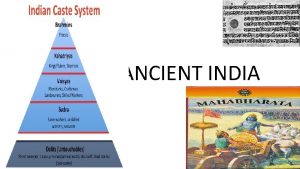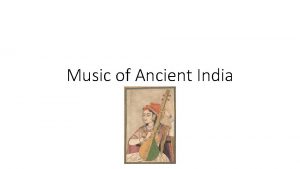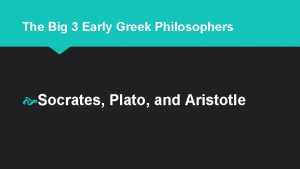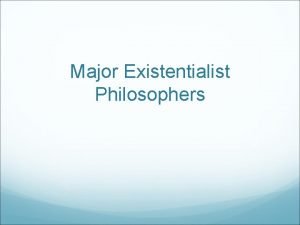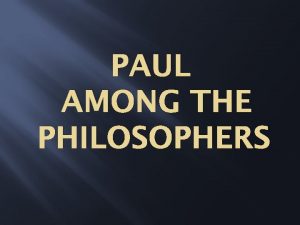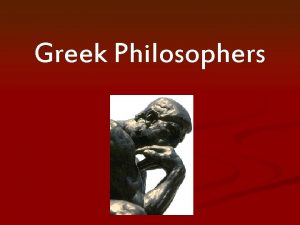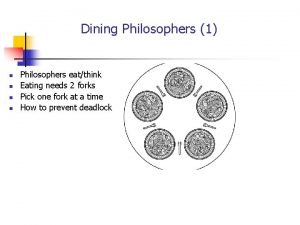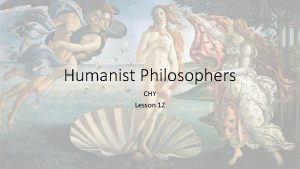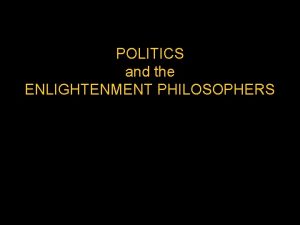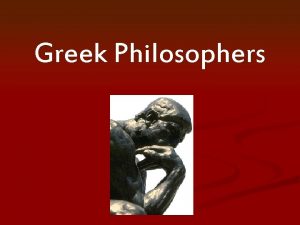Indian Value System Ancient Indian philosophers did not















- Slides: 15

Indian Value System • Ancient Indian philosophers did not neglect the social, the economic, and the emotional aspects of life. A careful study of ancient Indian history would reveal that this country was materially progressive and economically sound. • Speaking of prosperity of India in ancient times, Radhakrishnan says, ‘She knew how to chisel stone, draw pictures, burnish gold and weave rich fabrics.

• She developed all arts, fine and industries, which furnish the conditions of civilized existence. Her ships crossed the oceans and her wealth brimmed over Judea, Egypt and Rome. • Her conceptions of man and society, morals and religion were remarkable for the time. We cannot reasonably say that the Indian people reveled in poetry and mythology, and spurned science and philosophy, though it is true that they were more intent on seeking the unity of things than emphasizing their sharpness and separation. ’ It was therefore, natural for the philosophers of that time to bring about a synthesis of the social and economic, the emotional and spiritual life.

• On the other hand Indian ethics, instead of analyzing the nature of good, lays down practical means of attaining a life of perfection here and now. Ashrams Varnasrama Dharmas, or the duties of the individual and of the ethico-social organization of human beings. Even in the ascetic ethics of Jainisim, the rules of conduct have been practically followed by the Jains for thousands of years and are adhered to by them today.

• Kantian ethics exists only in the books of the West. Such, too, is the case with the utilitariansm of Mill. Thus Indian ethics is the actual application of moral ideals, whereas Western ethics is a mere discussion of ethical problems.

• Rig. Veda as well as Atharva Veda mention honesty, non-violence, truthfulness, modesty, agreeable speech, Brahmacharya (celibacy), religious conviction, and purity of heart as the important virtues that are praiseworthy. These very virtues are mentioned in the Bhagavadgita as divine qualities. Thus the Vedic philosophy lays emphasis on right conduct as the means of the development of the personality of the individual. Hence in a way the ethics of the Vedas is the ethics of right action.

• The existence of four major divisions (Varnas) of society, viz. (i) the Brahmana, the priestly class; (ii) the Ksatriya, the ruling class, (iii) the Vaisya, the professional class; and (iv) the Sudra, the labouring class, is clearly indicated in Vedic literature. The Vedic hymns refers to the metaphysical and social nature of the four major classes.

• The existence of four major divisions (Varnas) of society, viz. (i) the Brahmana, the priestly class; (ii) the Ksatriya, the ruling class, (iii) the Vaisya, the professional class; and (iv) the Sudra, the labouring class, is clearly indicated in Vedic literature. The Vedic hymns refers to the metaphysical and social nature of the four major classes.

The Purusarthas(a balanced and integrated view of life). • Wealth (Artha)becomes evil only when it is misused on account of lack of wisdom. The Upanishads repeatedly point out that everything that is desired for the sake of the self. • The concept of duty or Dharma in the Upanishads is not negative but out and out positive. It does not command us to give up or renounce the world, but rather to engage in the worldly strife, always aiming at the spiritual goal and subordinating all other desires to the strongest desire, or love for God.

• The Upanishadic notion of Kama(desire) is described as follows: ‘Kama, which we are asked to renounce, is not desire as such, but only the animal desire, lust, the impulsive craving of the brute man. Freedom from Kama is not blank passivity. Natural desires and inclinations are the spring board of all human actions. Therefore it is an important human value. • To sum up, we may say that Artha, Kama, Dharma and Moksa are at the same time essential methods for leading a meaningful life.

• Neither the path of indulgence (Pravirtti Marga) nor that of asceticism (Nivirti Marga ) is desirable. Indulgence in the enjoyment of the pluralistic spatio-temporal world without insight into its spiritual monistic basis is as harmful, antisocial, and anti-ethical as indulgence in a lower pantheism and equating good with evil without recognition of pluralistic nature of the empirical world is disastrous.

• The Bhagavadgita follows the philosophy of Samadarsana (the unitive view of the Ultimate Reality) and Visamavarttana (differentiated behaviour in the empirical world) to the core. • Referring to this devotion to duty, it has been remarked in the Bhagavad-Gita that one should prefer death, while performing one’s own Dharma to a change of professional duty. • Svardharme ninhanam sreyad, • paradharmo bhayavahah.

• The highest goal, the summum bonum is not only the well being, of human beings but of all the living creatures. The following Sanskrit verse sums up the Indian ethical ideal. • Sarve bhabantu sukhinah sarve santu niramayah • Sarve bhadrani pasyantu makaschit dukhabhagabhavet. • ‘May all be at ease; may all be sinless; may all experience happiness; may none experience suffering. ’

• The four ends of life, viz. : -- Artha, or wealth, for the development of body, Kama, or the fulfillment of desires, for the development of mind, Dharma, or morality, for the development of intellect, and finally Moksa, or spiritual perfection, for the development of the soul. Thus this ethicometaphysical system is present clearly in the Rigvedic philosophy and it is also reflected in the Upanishads, which emphasize the oneness of the universe and hence entail the same non-dual reality as the goal of the cosmos, of society, and of the individual.

• The Four Noble Truths (arya satya) • There is suffering (dukha) • There is cause of suffering (dukha samudaya) • There is a cessation of suffering (dukhanirodha) • There is a way leading to cessation of suffering (dukha-nirodha-gamini pratipat)

• The Eight-fold Path (Buddhism) • 1) Right Resolve (sankalpa) • 2) Right Intention (samyag drsti) • 3) Right Speech (vak) • 4) Right Action (karmanta) • 5) Right Livelihood or right living (ajiva) • 6)) Right Concentration (samadhi) • 7) Right Effort (vyayama) • 8) Right Mindedness or • Right Thought (smrti)
 Ancient greece jeopardy
Ancient greece jeopardy The indian place value chart
The indian place value chart Values of ancient greek culture
Values of ancient greek culture Apa itu value creation
Apa itu value creation Indian value system
Indian value system Vocab level d unit 3
Vocab level d unit 3 Ancient communication devices
Ancient communication devices Ancient india vs ancient china
Ancient india vs ancient china Ancient indian social class
Ancient indian social class Ancient indian music
Ancient indian music Ancient religious art
Ancient religious art Big 3 of philosophy
Big 3 of philosophy Physical education in ancient greece pdf
Physical education in ancient greece pdf The big three greek philosophers
The big three greek philosophers Greek philosophers ethics
Greek philosophers ethics Kierkegaard antihegelismo
Kierkegaard antihegelismo








